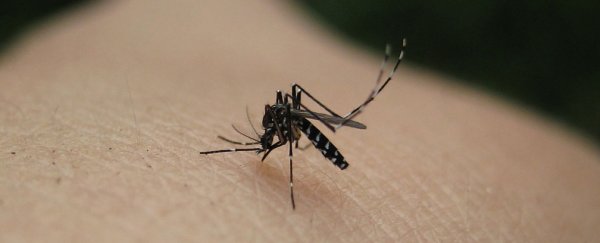Nothing mars the enjoyment of a balmy summer evening quite like the irritating bites and itches inflicted by a swarm of whining mosquitoes. Wherever we go, they seem to follow us, and now researchers in the US have finally figured out what makes them so adept at getting under our skin.
According to a team from the California Institute of Technology, mosquitoes use a three-pronged approach combining olfactory, visual, and thermal cues to locate any nearby hosts. It's this combination of three different kinds of sensory information that make mosquitoes so difficult to evade, especially when they can become attuned to our presence from as much as 50 metres away.
To test their hypothesis, the team conducted a number of experiments with female mosquitoes in a wind tunnel, controlling different kinds of sensory cues to see which conditions made the insects respond best. Injecting a high-concentration plume of carbon dioxide into the wind tunnel - to mimic the exhaled breath of people - made the insects follow the plume, whereas a control plume consisting of only background air had no effect.
In a second experiment, the team placed a dark object on the floor of the wind tunnel to act as a visual cue for the mozzies. They found that when CO2 was injected into the tunnel, the mosquitos honed in on the object, but when there was no CO2 present, they displayed no interest in the dark object at all. This suggests that mosquitoes are only attuned to visual cues if they've already been tipped-off by their sense of smell.
"Understanding how brains combine information from different senses to make appropriate decisions is one of the central challenges in neuroscience," said Michael Dickinson, lead author of the study, in a press release. "Our experiments suggest that female mosquitoes do this in a rather elegant way when searching for food. They only pay attention to visual features after they detect an odour that indicates the presence of a host nearby. This helps ensure that they don't waste their time investigating false targets like rocks and vegetation."
Finally, to measure which kinds of thermal temperatures mosquitoes are attracted to, the researchers heated one object to 37 degrees Celsius (approximate human body temperature) and left one at room temperature. The mosquitoes were attracted to the warm object, independent of whether CO2 was present.
"These experiments show that the attraction to a visual feature and the attraction to a warm object are separate," said Floris van Breugel, who was the first author of the study. "They are independent, and they don't have to happen in order, but they do often happen in this particular order because of the spatial arrangement of the stimuli: a mosquito can see a visual feature from much further away, so that happens first. Only when the mosquito gets closer does it detect an object's thermal signature."
An analysis of how the mosquitoes responded over the three experiments led the researchers to create a 'triple threat' model of how mosquitoes find their hosts. From 10 to 50 metres away, the insects use smell to detect a CO2 plume. This is what initially attracts them towards people and other animals. Within 5 to 15 metres of their target, mosquitos use their sense of vision, drawing closer to us via visual cues. Finally, once the insects are within 1 metre of their host, they detect thermal cues to further close in on their warm targets.
It's this three-pronged approach that makes it so hard to successfully evade mosquito bites, with the researchers acknowledging that there's not much people can do to throw mozzies off the scent.
"Even if it were possible to hold one's breath indefinitely, another human breathing nearby, or several metres upwind, would create a CO2 plume that could lead mosquitoes close enough to you that they may lock on to your visual signature," the authors write in their paper, published in Current Biology. "The strongest defence is therefore to become invisible, or at least visually camouflaged. Even in this case, however, mosquitoes could still locate you by tracking the heat signature of your body … The independent and iterative nature of the sensory-motor reflexes renders mosquitoes' host seeking strategy annoyingly robust."
